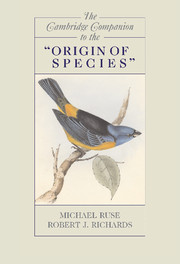Book contents
- Frontmatter
- Foreword
- Introduction
- 1 The Origin of the Origin
- 2 Darwin’s Analogy between Artificial and Natural Selection in the Origin of Species
- 3 Variation and Inheritance
- 4 Darwin’s Theory of Natural Selection and Its Moral Purpose
- 5 Originating Species: Darwin on the Species Problem
- 6 Darwin’s Keystone: The Principle of Divergence
- 7 Darwin’s Difficulties
- 8 Darwin’s Geology and Perspective on the Fossil Record
- 9 Geographical Distribution in the Origin of Species
- 10 Classification in Darwin’s Origin
- 11 Embryology and Morphology
- 12 Darwin’s Botany in the Origin of Species
- 13 The Rhetoric of the Origin of Species
- 14 “Laws impressed on matter by the Creator”? The Origin and the Question of Religion
- 15 Lineal Descendants: The Origin’s Literary Progeny
- 16 The Origin and Political Thought: From Liberalism to Marxism
- 17 The Origin and Philosophy
- 18 The Origin of Species as a Book
- Bibliography
- Index
10 - Classification in Darwin’s Origin
Published online by Cambridge University Press: 28 January 2009
- Frontmatter
- Foreword
- Introduction
- 1 The Origin of the Origin
- 2 Darwin’s Analogy between Artificial and Natural Selection in the Origin of Species
- 3 Variation and Inheritance
- 4 Darwin’s Theory of Natural Selection and Its Moral Purpose
- 5 Originating Species: Darwin on the Species Problem
- 6 Darwin’s Keystone: The Principle of Divergence
- 7 Darwin’s Difficulties
- 8 Darwin’s Geology and Perspective on the Fossil Record
- 9 Geographical Distribution in the Origin of Species
- 10 Classification in Darwin’s Origin
- 11 Embryology and Morphology
- 12 Darwin’s Botany in the Origin of Species
- 13 The Rhetoric of the Origin of Species
- 14 “Laws impressed on matter by the Creator”? The Origin and the Question of Religion
- 15 Lineal Descendants: The Origin’s Literary Progeny
- 16 The Origin and Political Thought: From Liberalism to Marxism
- 17 The Origin and Philosophy
- 18 The Origin of Species as a Book
- Bibliography
- Index
Summary
A PUZZLE
Textbook histories tell us that Charles Darwin sparked a scientific revolution with the publication of his Origin of Species in 1859. While this revolution is obvious in many biological disciplines, it is less so in biological taxonomy or systematics - the grouping and classification of organisms. After all, the approach most of us learn in school today was first developed by Linnaeus in 1735 - 124 years before the Origin. That being the case, where is the revolution? Systematist Ernst Mayr expresses this doubt: “As far as the methodology of classification is concerned, the Darwinian revolution had only minor impact” (Mayr 1982, 213). Mayr is right in that the Linnaean hierarchy predated but also survived the Darwinian revolution, and has remained in use today. But it would be wrong to conclude that the Darwinian revolution was irrelevant to classification.
My intention here is to sketch out Darwin’s influence on classification and the role classification played in his larger project. We shall see that despite the superficial similarity between pre- and post-Darwinian classification, Darwin’s influence has nonetheless been profound. He gave systematics a theoretical foundation and an operational method. Moreover, classification was important to Darwin’s project. His discussion of it in the Origin comes at the end, unifying and drawing together threads from important topics in earlier chapters – natural selection and divergence, comparative anatomy and morphology, and embryology and development.
- Type
- Chapter
- Information
- The Cambridge Companion to the 'Origin of Species' , pp. 173 - 193Publisher: Cambridge University PressPrint publication year: 2008



